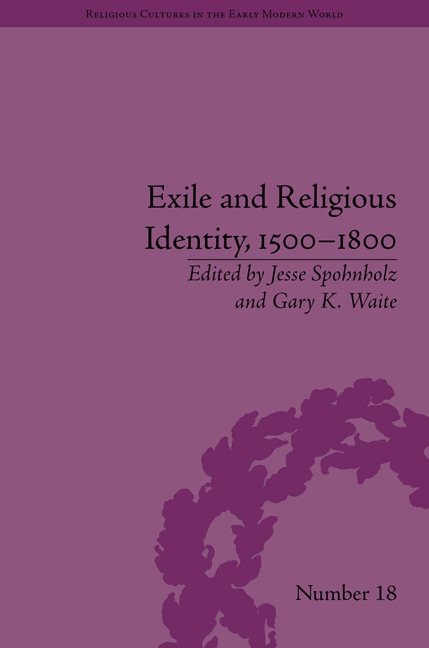Book contents
- Frontmatter
- CONTENTS
- Acknowledgements
- List of Contributors
- List of Figures and Tables
- Introduction
- Part I The Experience of Exile and the Consolidation of Religious Identities
- 1 ‘Count Every Step in my Flight’: Rhegius's and Luther's Consolations for Evangelical Exiles, 1531–3
- 2 Saints beyond Borders: Relics and the Expatriate English Catholic Community
- 3 Religious and Family Identity in Exile: Anne Percy, Countess of Northumberland in the Low Countries
- 4 The Reformed of Orange: Community Identity and Exile
- Part II The Experience of Exile and the Destabilization of Religious Identities
- Part III The Memory of Exile
- Notes
- Index
3 - Religious and Family Identity in Exile: Anne Percy, Countess of Northumberland in the Low Countries
from Part I - The Experience of Exile and the Consolidation of Religious Identities
- Frontmatter
- CONTENTS
- Acknowledgements
- List of Contributors
- List of Figures and Tables
- Introduction
- Part I The Experience of Exile and the Consolidation of Religious Identities
- 1 ‘Count Every Step in my Flight’: Rhegius's and Luther's Consolations for Evangelical Exiles, 1531–3
- 2 Saints beyond Borders: Relics and the Expatriate English Catholic Community
- 3 Religious and Family Identity in Exile: Anne Percy, Countess of Northumberland in the Low Countries
- 4 The Reformed of Orange: Community Identity and Exile
- Part II The Experience of Exile and the Destabilization of Religious Identities
- Part III The Memory of Exile
- Notes
- Index
Summary
It is possible to discern two major changes in the historiography of post-Reformation England in recent years in which the theme of exile plays an important role. Firstly, there has been a greater emphasis on Catholics and Catholicism in England, to be studied not as a marginalized minority group or religion, but as part of the complex tapestry of lived religion in early modern England. In this approach, considering the many different encounters between ‘Protestant’ and ‘Catholic’ can be a means of gaining a deeper understanding of post-Reformation religion and politics. Secondly, an attentiveness to the relationship between England and its neighbours, both within the British archipelago and within a ‘European’ context, has led to a discussion of the significance of these contexts for the story of religious change. These shifts have offered new insights in a number of areas, including that of religious exile to and from the Tudor realms. This helps to revisit a fairly deep-rooted tendency to Anglocentrism among historians of early modern England, and opens the field to work of a more comparative nature. The English Catholics who went overseas, for example, can be usefully compared to their counterparts in continental Europe. Research on religious change in mainland Europe has resoundingly demonstrated that exile was a key constituent of Catholic as well as Protestant identity.
- Type
- Chapter
- Information
- Exile and Religious Identity, 1500–1800 , pp. 39 - 50Publisher: Pickering & ChattoFirst published in: 2014

